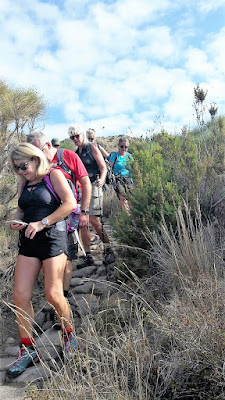Ingredienti: Kg. 1 farina, gr. 150 strutto, gr. 150 zucchero, 2 uova intere e 2 tuorli, un bicchiere di malvasia. Amalgamare la farina con lo strutto zucchero uova e in fine la Malvasia (vi raccomando quella originale). Mettere in frigo a riposare e preparare il ripieno tritando le mandorle con lo zucchero la cannella il mandarino. Stendere la frolla e porre un po' del ripieno al centro di ogni dischetto e coprire con un altro dischetto, sigillando tutto attorno con le dita e rifilando i bordi con una rotella dentellata i bordi. Pizzicare e intagliare la superficie dei nacatuli in modo da abbellirla con disegni di fantasia e varie forme in rilievo. Quindi cuocere i nacatuli in forno a 180 °C fino a leggera doratura (20 minuti circa).
Non dimenticate tra i vari souvenir di mettere in valigia un geco in ceramica, segno di buon auspicio e buona fortuna!!
Paola F. J. Torrisi
Lipari between archaeology and eco-sustainability
The mother of the Aeolian Islands, the ancient Meligunis, so called for the sweetness of its climate and favorite destination of different targets for trekking, archeology and eco-sustainability, certainly deserves attention even the old town, dominated by the fortified walls called Castle, located on a high cliff overlooking the sea, from which you can admire a beautiful landscape. But other panoramic points will allow you to make indelible postcards and breathtaking images such as those of Belvedere Quattrocchi, a natural balcony!
Archaeology
Its Acropolis, a natural fortress that encloses within its walls 6000 years of history, ancient civilizations, Neolithic men who came here in the wake of obsidian, the sharp black stone that made the archipelago the center of the most flourishing traffic in the Mediterranean, is also known for its white mountain of pumice that plunges into the sea offering a backdrop of unreal colors with warm Caribbean tones.
Among the most interesting places it is possible to visit the Aeolian Regional Archaeological Museum, located in the complex of the Castle of Lipari, and one of the most important in the Mediterranean and has about fifty rooms, in which archaeological materials are exhibited in chronological order. It is possible to admire precious materials coming both from the inhabited area and from the funerary equipments, vases, stones, tombstones and sarcophaguses that testify the evolution of the cult of the dead. Also, ceramics of various types and fashions, theatrical masks and clay statues.
The Baths of San Calogero are the most important spa on the island, although not the only one, discovered in 1984, has led archaeologists to assume that the Baths of San Calogero were already used in the fifteenth century BC, which makes the spa of Lipari the oldest in the Mediterranean Sea. Since 2013, an Ecomuseum of Memory has been created on the history of the San Calogero Baths and the pumice of Lipari.
Eco-sustainability
Lipari together with Panarea have placed themselves in the front row in the fight against disposable plastic. Many tourists choose a destination, not only for its beauty, but the impact on nature of our choices is a fairly hot topic for small islands in general, protected and loved first by those who live them all year round. Other accommodation facilities on the island have recently begun a sustainable path, but for some time others have set themselves objectives of economic development compatible with respect for the environment.
For lovers of Trekking
The paths for trekkers invite tourists to plan their vacations mixed to the discovery of paths that aim to leave travelers speechless ... up to the Quarries of kaolin through Acquacalda, continuing up to San Calogero you can admire what remains of the hot springs and the most picturesque parts of the west coast of Lipari.
Liparian delicacies
Sicily is known all over the world for its food and wine, but those who have been to Lipari cannot miss the bread cunzato in Marina Corta, a wine tasting experience at sunset accompanied by an unexpected view, the tasting of the real Malvasia with Piparelle, fish cooked as you have never tasted it... The Aeolian cuisine is characterized by the wise use of aromatic herbs such as rosemary, oregano, basil, garlic, mint and above all capers and Malvasia.
Among the typical sweets of the Aeolian tradition there are "Gigi", "acauli", "sesamini", "pasticciotti" of pumpkin and "spicchitedda".
Thanks to an interview with Adelia, Liparota Doc and expert in local tourism, we had the pleasure of having told the process of the traditional cookies of Lipari, those that she used to make with her mother and with much affection and esteem she wanted to give us the original recipe!
The Nacatuli Eoliani, Sicilian short pastries flavored with Malvasia wine and filled with a fragrant filling of almonds, sugar, cinnamon and citrus fruits. Meticulously embroidered with the "pizzicarolo" tool handcrafted by local people.
Ingredients: Kg. 1 flour, gr. 150 lard, gr. 150 sugar, 2 whole eggs and 2 yolks, a glass of malvasia.
Mix the flour with the lard, sugar, eggs and Malvasia (I recommend the original one). Put in the fridge to rest and prepare the filling by chopping the almonds with sugar, cinnamon and mandarin.
Roll out the shortcrust pastry and place a little of the filling in the center of each disc and cover with another disc, sealing all around with your fingers and trimming the edges with a pastry wheel. Pinch and carve the surface of the nacatuli so as to embellish it with fancy designs and various raised shapes. Then bake the nacatuli in the oven at 180 ° C until lightly browned (about 20 minutes).
Don't forget to pack a ceramic gecko as a souvenir of good luck!
Paola F. J. Torrisi
Thanks to Siciliamagazine.net
#TakeitSlowlyByUnAltraSicilia








Nessun commento:
Posta un commento